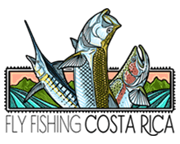Planning a fly fishing trip to Costa Rica to escape the winter chill? Thankfully, Costa Rica’s dry season overlaps perfectly. Costa Rica is home to over a thousand different species of fish, so deciding where to go and what to target can be a little overwhelming. Thankfully we’ve already done the work for you! Check out the article below to learn about fly fishing Costa Rica’s dry season, and give yourself a heads up on planning your trip.
Why Visit Costa Rica in the Dry Season?
When one thinks about Costa Rica, they picture sandy beaches, waving palm trees, and warm climate. Travelers seeking an escape from the cold winters of northern latitudes are in luck, as Costa Rica experiences its dry summer season from November to April. During this time, the weather is generally warm and sunny, with temperatures ranging from the mid-70s to the mid-90s Fahrenheit (around 24 to 35 Celsius). Tourism explodes during this time – Costa Rica normally has a population of just under six million people, and three million tourists visit the country annually. The rains of the previous months are forgotten, and there are plenty of activities available.
Many tourists visit for surfing, hiking, zip-lining, and exploring the country’s many national parks and wildlife reserves. Some of the most popular destinations include Manuel Antonio National Park, Arenal Volcano National Park, Monteverde Cloud Forest Reserve, and Tortuguero National Park. The beaches are also a major attraction during the summer months, with crystal-clear waters and golden sands. Popular beaches include Tamarindo, Jaco, Santa Teresa, and Playa Conchal.
But the low waters and warm temperatures also draw in fly fishers, and there are plenty of angling opportunities available. From exhilarating saltwater adventures chasing roosterfish to a tranquil afternoon fishing trout in a mountain stream, fly fishing Costa Rica’s dry season is sure to please.
A Relentless Exotic – Fly fishing for Roosterfish in Costa Rica
Saltwater fishing is often a dream for the traveling angler. The dry season in Costa Rica is an excellent way to knock some of those species off your bucket list! One of the most iconic species that lives on Costa Rica’s Pacific coast is the roosterfish. Roosterfish have a distinct appearance, with a tall, comb-like dorsal fin that resembles a rooster’s comb. They are strong and powerful fish, and can grow up to 4-5 feet long and weigh over 100 pounds. Capable of blistering high-speed runs, roosterfish are tenacious and stubborn, making them a thrilling catch. Peak season for roosterfish in Costa Rica coincides with the summer months, ranging from November to April. While they can occasionally be caught from shore, the best odds to get tight to one is to head inshore on a boat.
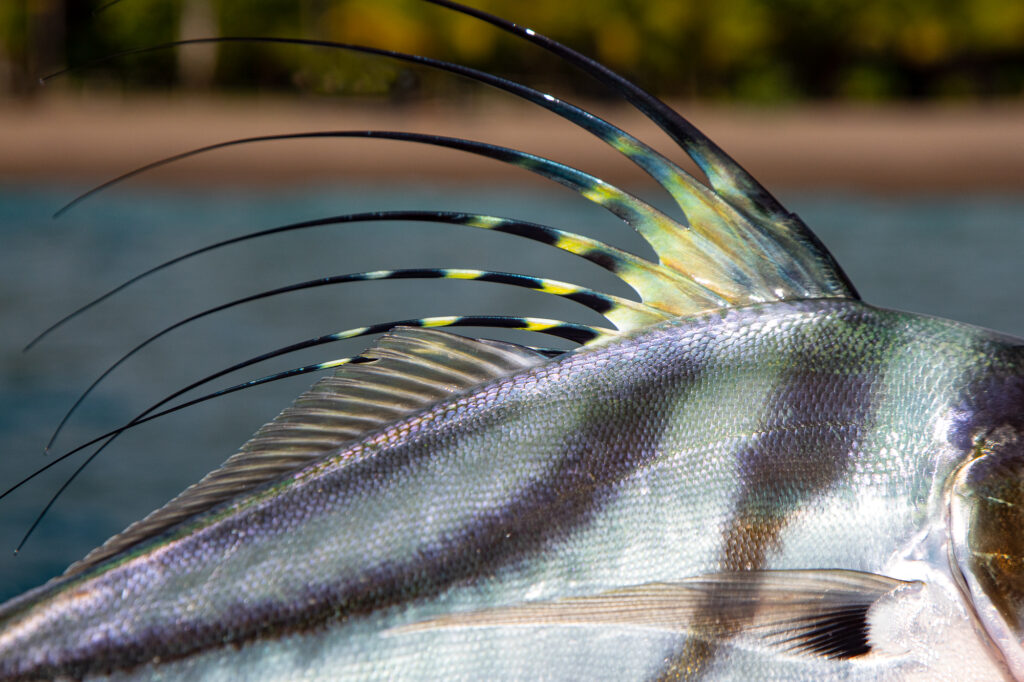

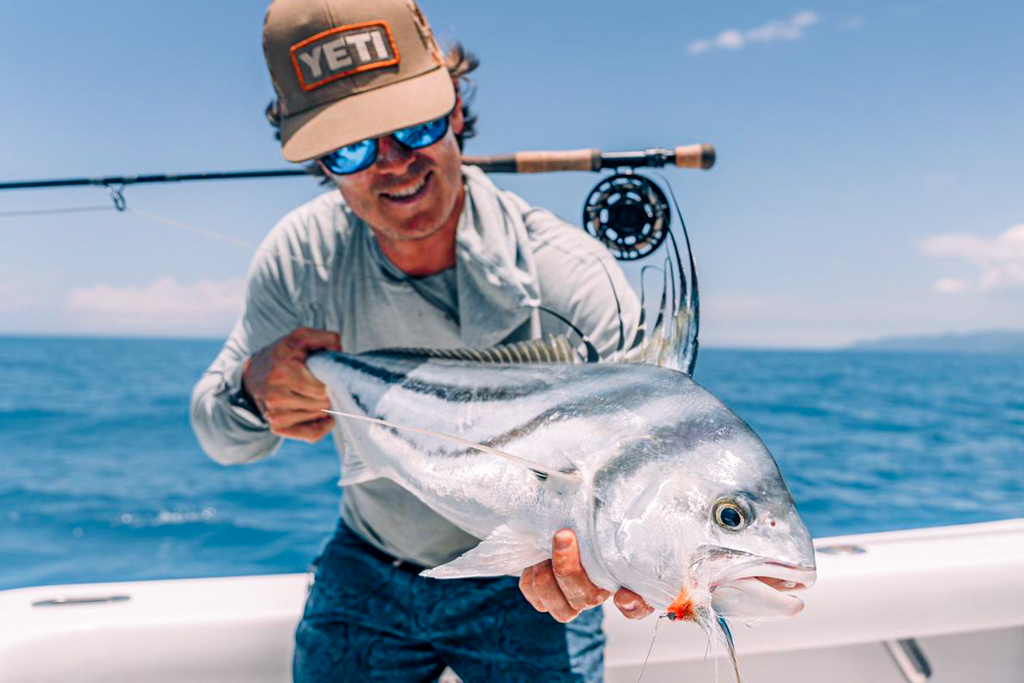
Boats can cover great amounts of water, and additionally get tight to the rocks and reefs that are inaccessible to the shore bound fly fisher. Trolling hookless live baits draws roosterfish up from the depths and into a frenzy. From there, a quick accurate cast with a rapid retrieve is often all that’s necessary to get a hookup. Additionally, your guide can cast a large hookless popper at the rocks to get the attention of local roosterfish, and present an opportunity with the bait-and-switch. Bring your heavy fly gear! 10 wt rods are the minimum, and make sure you have a high-quality saltwater fly reel with an excellent drag!
Offshore Speedsters – Sailfish and Tuna in Costa Rica
Other immensely popular saltwater gamefish in Costa Rica are sailfish and tuna. In the southern part of Costa Rica, the summer months are the peak time for these offshore speedsters. During this time, the waters off the Pacific coast are typically calmer and clearer, making it easier to spot fish and for boats to navigate. Sailfish can grow up to 10 feet long and weigh over 200 pounds, making them a formidable opponent for anglers. They are incredible acrobats, and are one of the fastest fish in the ocean. Many anglers choose to set sail out of Quepos, Drake Bay, Puerto Jiménez, and Golfito, where there are an array of charter operators who are experts in fly fishing.



Sailfish are commonly raised while trolling a spread of hookless lures. When the sailfish attacks the spread, the teaser is quickly reeled in and the angler places the fly in front of the excited sailfish. Fly selection is simple – anything works, as long as it’s pink! Tuna can often congregate around schools of baitfish, feeding voraciously. If you’re lucky enough to find a blitzing school, it can be as simple as putting a fly in the vicinity and watching it get walloped. Both of these fish require very heavy gear – 12 wt fly rods at a minimum, with 14 wt rods preferred. And it goes without saying that a strong reel with lots of backing is a must!
Want to learn more about the saltwater fisheries found in Costa Rica? Click here to find out more!
The Fruit-Eating Piranha of Costa Rica: Machaca!
Fly fishing during Costa Rica’s dry season isn’t just about saltwater. Low water levels provide great flow in the country’s many freshwater rivers, and there lies some of the most exciting fly fishing in Costa Rica! One tropical species that’s a superb quarry on the fly rod is the machaca (Brycon behreae & Brycon costaricensis). This relative of the piranha lives in fast-moving lowland rivers throughout Costa Rica, although the Pacific drainages fish better in the dry season. Prime areas to fish machaca are Tamarindo (and most of the Northern Pacific coast in Guanacaste), La Fortuna, Monteverde, and Quepos.
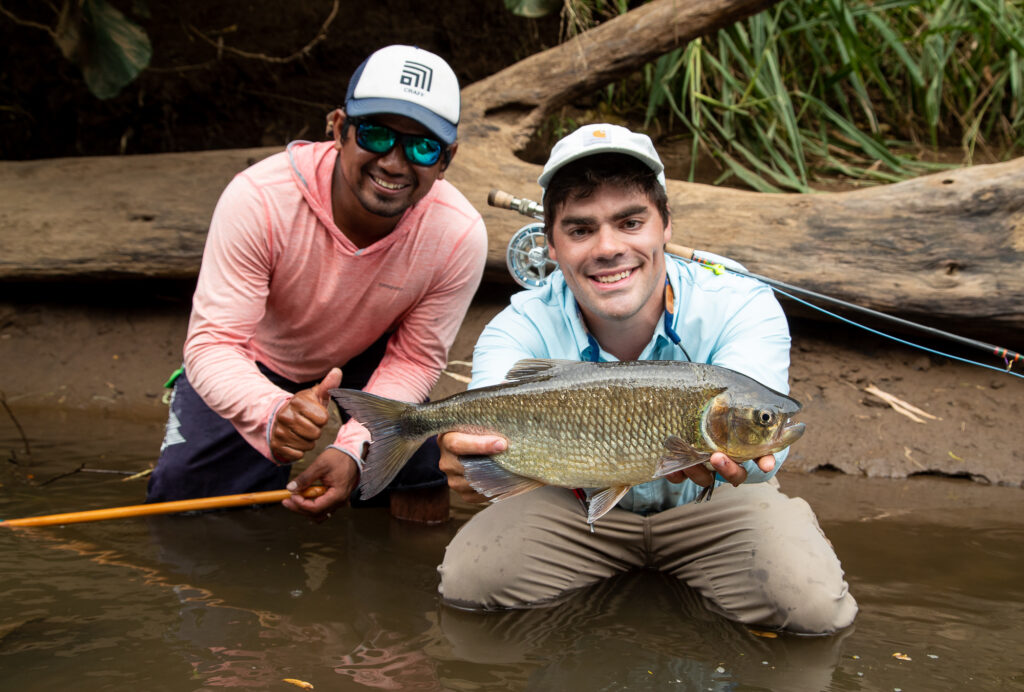
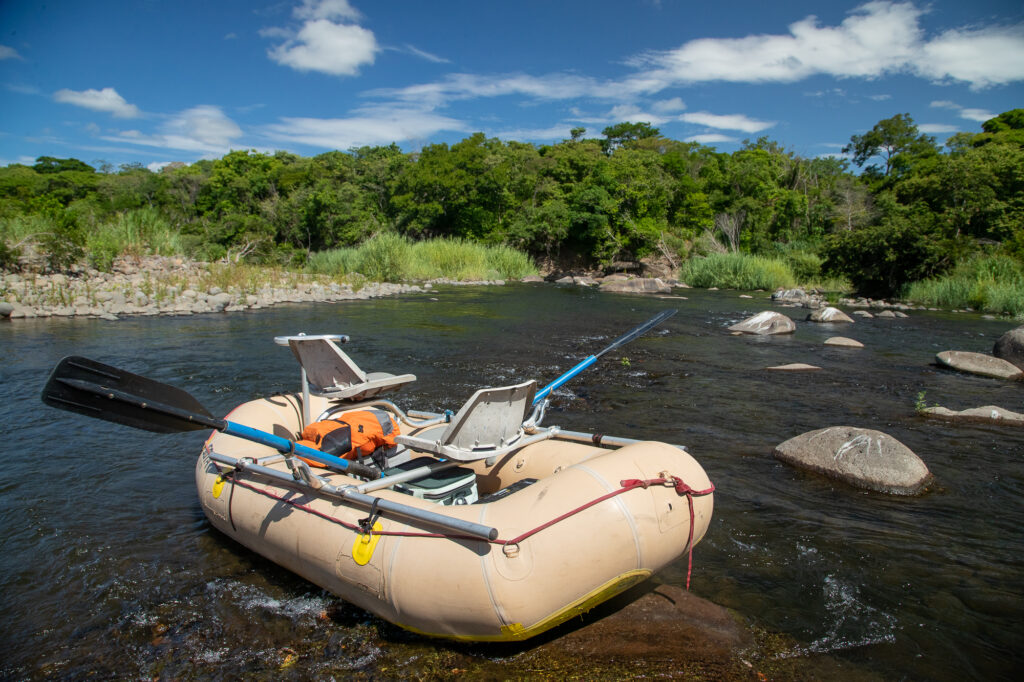
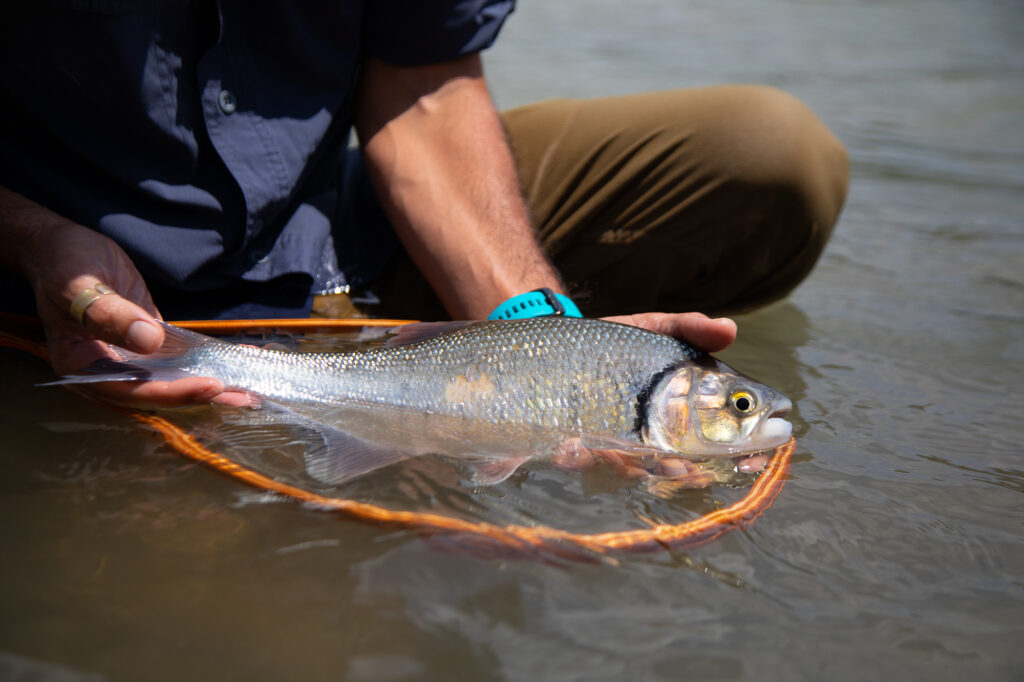
Machaca are primarily vegetarians, feeding on fruit and flowers that fall into the water. The bay cedar (guacimo) and wild cashew (espavel) trees drop their fruits in the summertime, with the guacimo peaking in February and the espavel during March and April. Machaca congregate under these trees, and voraciously attack anything that falls into the water. This is a perfect combination for the fly fisher – eager fish and topwater action!
Awesome Driftboat Action!
There are two key things to remember when fishing for machaca in Costa Rica. While machaca reside in all types of water, they love rapids. Additionally, because machaca can key into specific forage during any given month, they most often congregate under very specific trees on the river. Due to these factors, it’s best to fish for machaca from a drift boat. This allows the angler to cover lots of water in a morning float.
Machaca fishing in Costa Rica is often described as a combo whitewater rafting and fishing trip. You’ll go through sections where you need to hang onto your hat, and then immediately start casting to the numerous eddies, runs, and current seams. To help you find the best spots, your guide will help point out the fruit-laden trees as you round each bend. And because the majority of the machaca’s diet is fruit, a very special gear setup is required to succeed.
Essential Gear for Fly Fishing Machaca
First and foremost, you need a fruit fly! Fruit flies are simple to make, but they’re unlike any fly you’ve ever cast before. A chunk of wine cork is cut, sanded, mounted to a hook and painted to match the prevalent fruit. For a tutorial on how to make a fruit fly, click here! Pair 6-8 wt fly rods with a floating line to cast these heavy flies. And your leader should be short – two and a half feet of 20 lb nylon, with a six-inch bite tippet of 30 lb fluorocarbon.
What’s important to remember when fishing for machaca in Costa Rica is that you need to get their attention. And you do this by the “splash cast”. The fly fisher casts a wide-open loop, and powers the fruit fly into the water. No delicate presentations here- the goal is to create the most noise possible! This also makes machaca fishing easily accessible to beginners- the casts are short, easy, and the action is constant. If you toss a fruit fly under an espavel tree during peak season, get ready- often times a half dozen (or more) machaca will pounce on your fly. The fly fisher who has a fast hookset will be rewarded with an awesome fight- aerial jumps like a tarpon, and long bulldogging runs like a redfish. But once they’re in the net, be careful- the teeth of the machaca are sharp!
For more information on floating the rivers for machaca, click here!
Escaping the heat with rainbow trout in the cloud forest
The sun and high temperatures of Costa Rica’s dry season is no joke. Shorts, sandals, and a tank top are the attire of choice when hanging out on the beach (along with plenty of sunblock!). Many travelers choose to end their vacation in the high-altitude mountains of Costa Rica’s Dota region, enjoying a welcome respite from the coastal and lowland heat.
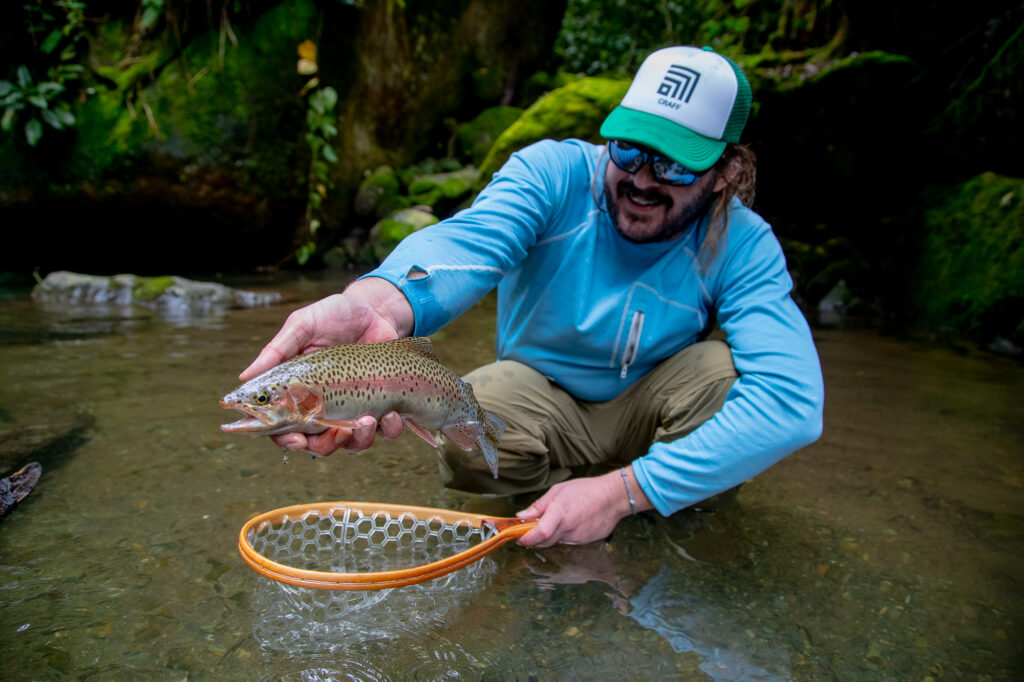


Here temperatures can be as low as 46 degrees Fahrenheit in the early mornings. A warm jacket and a fresh cup of coffee is necessary to beat the chill. This is the cloud forest, a zone of high humidity. Epiphytes such as bromeliads, ferns, and orchids drape from the towering trees. The area is home to exotic birds such as the resplendent quetzal, and multitudes of hummingbirds flit from flower to flower. This area is a haven for bird watchers, and hotels fill up fast! But the cloud forest is also the perfect destination for the fly fisher, as it’s home to an unexpected treat- wild rainbow trout.
Rainbow trout in Costa Rica? How?
Rainbow trout were first introduced into Panama in the early 1900’s. They thrived in the cool, high altitude mountain streams, and soon spread throughout Central America, arriving in Costa Rica in the 1950’s. While not a native fish, the populations of rainbow trout in Costa Rica are wild and thriving. These rainbow trout are perfectly adapted to their gin-clear waters, with large eyes that are ready to pick off any insects drifting in the current. They exhibit incredible colors and parr marks, and even the smallest fish is a work of art. Costa Rica’s dry season is a wonderful time to fly fish for rainbow trout, as the rivers are low and clear. Wading is easy, and by 9 AM the weather is perfect, with temperatures in the mid-70’s Fahrenheit. And the rainbow trout are ready and willing to take the fly.
World-class rainbow trout fly fishing
Fly fishing for rainbow trout in Costa Rica is very similar to fishing for trout worldwide. 3-5 wt rods are the norm, paired with a good floating line. Tenkara rods are also an excellent tool here, as many sections of the river don’t require long casts. Common techniques used to catch rainbow trout are fishing with a hopper dropper, indicator nymphing, and tightline nymphing. The main difference with Costa Rican rainbow trout is that Costa Rica doesn’t have hatches like are found in northern latitudes. The water temperature of their rivers is relatively constant due to the mountain runoff. Aquatic insects emerge sporadically, rather than in waves. Therefore, dry fly fishing can be tricky- although the trout will often take a CDC midge or terrestrial fly pattern. For subsurface fly patterns, size 12-18 tungsten beadhead nymphs tend to produce quite a few takes.
And make no mistake, the rainbow trout are ready to eat! Costa Rica has world class trout fishing, for beginners and experts alike. It’s a fantastic place for families to learn to fly fish, due to beautiful scenery and the amount of trout. Most beginners walk away with a couple dozen trout released for the day. Experts who are willing to perfectly drift a nymph through some of the deeper pools can be greatly rewarded. Rainbow trout of up to 20 inches are lurking in the depths! It’s an unmissable fly fishing experience of Costa Rica.
Visiting trout bums: this link will take you to the good stuff!
Come enjoy the dry season with us!
The majority of Costa Rica’s tourism comes during the dry season, and for good reason. The weather is beautiful, the temperatures warm, and the Pura Vida lifestyle is in full swing. Traveling anglers who are interested in fly fishing Costa Rica’s dry season have a slew of options available to them, and there’s something for every experience level and budget. Check out the links below, and please contact us with any questions! We’re here to help you have an unforgettable Costa Rican vacation.
Want to learn more about the saltwater fisheries found in Costa Rica? Click here to find out more!
For more information on floating the rivers for machaca, click here!
Visiting trout bums: this link will take you to the good stuff!
Interested in combining birdwatching and fly fishing? Check out our Fin & Feathers program!
